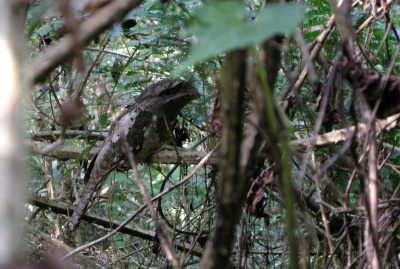- Batrachostomus moniliger
Identification
23cm (9 in). Unmistakable in natural range.
The male is brownish-grey with black-and-white markings and vermiculations. White markings form a small collar across the upper mantle and are prominent on scapulars, wing-coverts and flanks and belly.
The female is more uniform and rufous to brown in coloration.
Distribution
The Sri Lanka Frogmouth is found in India and Sri Lanka. This secretive bird lives from Goa south to Kerala in the Western Ghats high rainfall forests, usually in the lowlands (up to 1800m) and in Sri Lanka in the wet southwest. It may be overlooked in some places.
Taxonomy
A member of the Frogmouth family Podargidae and one of 9 species of the genus Batrachostomus. Although some similarities with Hodgson's Frogmouth Batrachostomus hodgsoni are shared this two species do not form a superspecies.
Considered monotypic, but further study is needed as there are some differences in bill size, tail length and plumage tone between birds from India and Sri Lanka.
Habitat
Found in dense, primary or secondary humid forest. Often in bamboo thickets and generally in the understorey. Not found in plantations and heavily disturbed forest.
Behaviour
Nocturnal. Roosts by day in dense undergrowth, e.g. bamboo thickets where it is extremly difficult to see. Usually found single, in pairs or small groups.
Diet
Feeding habits poorly known, may act like other frogmouths, perching in a tree to descend fast to feed on moths, beetles and grasshoppers.
Breeding
Breeding from January to April, but also recorded in other months. The nest is well hidden on a horizontal branch or in a tree fork. Lays 1 egg.
Movements
No movements known.
References
- Clements, J. F., T. S. Schulenberg, M. J. Iliff, S. M. Billerman, T. A. Fredericks, B. L. Sullivan, and C. L. Wood. 2019. The eBird/Clements Checklist of Birds of the World: v2019. Downloaded from http://www.birds.cornell.edu/clementschecklist/download/
Recommended Citation
- BirdForum Opus contributors. (2025) Sri Lanka Frogmouth. In: BirdForum, the forum for wild birds and birding. Retrieved 12 March 2025 from https://www.birdforum.net/opus/Sri_Lanka_Frogmouth
External Links
GSearch checked for 2020 platform.1





